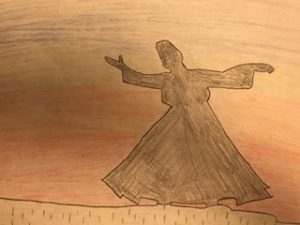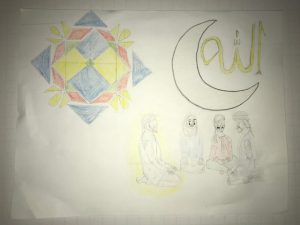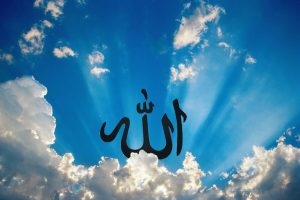Prologue
ø
Before taking this course, the knowledge I had about the faith was through my own practice and the baseline education I received growing up. I had many assumptions about the faith stemming from what I saw on the media, how I saw community members practice the faith, and my own perceptions of what it means to by Muslim. I always felt like there was never a lot of clarity on some of the most fundamental parts of the faith. This classed forced us to question big picture thoughts we often take for granted: Who’s Islam are we talking about? Who decides what Islam or not? Of your knowledge of Islam, how do you know it? Before taking this class, I did have exposure to the arts in Islam growing up; however, I had little knowledge of the history, the purpose, or true spiritual significance it serves for people. Throughout the course of the semester, I have been exposed to art, interpretations, and various Muslim cultures that have redefined my thinking and gave answer to many of the questions I have always wondered about my faith. Through my blogposts, I hoped to create art that is effective in sharing knowledge, the vast interpretations of Islam, history, and shows the relationship between the arts and personal interpretation of the faith
Professor Ali Asani emphasis on designing the course through a ‘cultural studies’ approach is what allowed students to really understand and break own big questions and assumptions about Islam. Through this approach, Professor Asani emphasized that Islam is not a tangible thing but is constructed by concept and shaped by experience that is based off one’s social, economic, political, and cultural context. As he points out in Infidel of Love:
“A person’s description of Islam, whether or not he or she is Muslim, is based on what he or she has subjectively experienced, perceived, read, or been taught. People may hold strikingly contradictory conceptions of Islam depending on their point of view: for some, Islam is a religion of peace, while for others it is a political ideology that promotes violence; for some, it is a religion that oppresses women, for others it is a religion that promotes equal rights; many believe its teachings are compatible with democracy and fundamental human rights, while others associate them with dictatorship and tyranny.” (5)
Professor Asani makes a critical point that Islam truly is something constructed by an actor to create it however they choose to interpret the faith. When we are able to grasp how subjective faith is, we see why there are various manifestations of the Islam practiced in a wide range of Muslim communities. From the Berti of the northern Darfur Province of Sudan ‘drinking the Qur’an’ to the Qawwali singers in South Asia, we learned how wide spread and varied the practice of faith is in Islam. The ability to grasp a cultural studies approach, in a time of globalization and mass media coverage of all types of phenomena, is critical as professor Asani notes in Infidel of Love:
“By emphasizing that every religious tradition is composed of multiple communities of interpretation, the cultural-studies approach gives us a vocabulary in which to frame this problem. It helps think about issues of representation by recognizing how interpretations associated with groups who have access to power dominate our perceptions of a tradition and come to be considered as “orthodox” or “mainstream,” eclipsing those associated with marginalized groups who have been side-lined and perceived as “heterodox.” (13-14)
With this in mind, I will move into some of the big picture takeaways from the class that are critical for truly understanding Islam and my art as a whole. First, for understanding my “Qur’an as an Experience” post we must consider the first instance of revelation to Prophet Muhammed from God, through Angel Gabriel, the Prophet was succumbed by shaking and fear from his experience. As he received more revelation, the prophet would often go in a trance like state. I drew the Prophet with a yellow halo surrounding him to represent the divine message engulfing his being. The three others surround him- his wife Khadijah, her cousin Waraqah ibn Nawfal, and his son in law Ali- represent some of the first to experience this divine message. In this, he would recite the Qur’an orally as mentioned in Zia Sardar’s Reading the Qur’an:
“Muhammed repeated each revelation to his growing circle of followers, who committed the words to memory” (15)
Thus, Muslim initially experiences the Qur’an orally, not through a book. The oral tradition is where the aesthetics and beauty of the texts lays as mentioned by Kristian Nelson in The Sound of the Divine:
“For the Qur’an must be heard, not merely read. As the order of God transmitted to the Prophet Muhammed, it is considered to be the actual sound of the Divine, the model of perfect beauty, and a testimony to the miracle of human and divine interaction” (257)
From this, came a stem of practices and ways to read the Qur’an from those that have memorized it in its entirety to the various ways it is expressed through music and dance.
The Quran was only fully written into the full book we have today after Prophet Muhammed’s death where he left instructions on how it should be codified. When this finally happened, it led a domination of a written, learned culture over an oral one. Thus, those that were able to read, often times the elites, became the leaders in interpreting the faith- creating a ruling religious class. This ‘claim to authority’ as I like to call it, combined with wealth and political power, have allowed certain groups and scholars to claim religious authority in interpretation. These authorities try to claim what is Islamic or not; however, in my blogs I try to show a variation of opinions and beliefs through my artwork and its description. Specifically, in my “Qur’an as an Experience” blog I tries to implement geometric shapes, the moon and Allah in Arabic, and the prophet reciting to represent the aesthetics of the Qur’an.
Moving into more critical takeaways from this class that are important background knowledge for my blogs, I’d like to first express how Professor Asani explained the concept of ‘islam’ versus ‘Islam’. Since Islam literally means submission to God, ‘islam’ refers to submission to the will of God (Jews and Christians aka ‘People of the Book’ and can even be extended to even those outside of monotheism to even all of God’s creation) with everything technically being ‘muslim.’ “Islam” refers to followers of Prophet Muhammed or the Ummah(‘Muslim’) which was established as a way the community distinguished itself from other monotheists. Initially, the Shahadah or creed to faith was “There is not God but God” but was made to be “There is no God but God and Muhammed is his messenger” to set the Muslim Ummah apart.
Similarly, Professor Asani emphasized how prophets play a key role in building bridges between Judaism, Christianity, Islam and other traditions as well. Critical to understanding the Qur’an is the fact you cannot understand many of its stories and history without referring to Jewish and Christian texts which allow us to see the equality of all prophets in their submission to God. Prophets serve as a role model for mankind, and for general Muslim consensus Prophet Muhammed is the seal of prophethood, and thus is superior to all prophets.
Through “The Nur(Light) of God” blog I sought to represent this continuity through nature itself- the creation of God. The fact that the light disperses everywhere is a reference to how I tried to elucidate the ‘physical light’ of this world with the Allah being the center of this ‘spiritual light’ here:
“We will show them Our signs in the horizons and within themselves until it becomes clear to them that this is the truth” [Qur’an 41:53]
Through the bridging of the prophets, we can see how light I described through my photo-bringing to life what is in the darkness- represents the signs of God through his prophets.
Moving into the Mevlevi who practice dhikr or remembrance through whirling, my blog “Sufism: Kinesthetic Spiritualism- “Whirling Dervish’ was inspired by much of the lectures Professor Asani taught on Sufism. What caught my attention, is how the Sufism -an esoteric outlook- is actually embedded within the Qur’an itself. The Qur’an asks mankind why are you so mesmerized with the physical world and not in touch with the real? Professor Asani points out how the ‘Zahir’ or outer, physical world is this and the ‘Batin’ or the inner, eternal reality is where God exists. This breaks down the dimensions of our ego, desires, and material obsession to be fleeting in comparison to the real existence of God.
Many Muslim communities across the world connect with the ‘Batin’ through many types of dhikr. Through my ‘Whirling Dervish’ blog I sought to show how one can connect to the divine through kinesthetic movement. Within the spin depicted, the Dervishes seek to unleashing themselves from worldly desires and distractions. I drew the Dervish black to represent the emptiness that happens through the process and the beautiful colors surrounding them represent the light of God (God’s Will) filling their hearts.
Through a similar process, I was inspired to show the process of letting go of earthly desires and egos, through my “Conference of the Bird” blog where I drew the hoopoe bird filled with a multitude of colors to represent the divine light. The variations of color are very important in the drawing as it represents the egalitarianism of believers and humanity:
“O mankind, indeed We have created you from male and female and made you peoples and tribes that you may know one another. Indeed, the most noble of you in the sight of Allah is the most righteous of you. Indeed, Allah is Knowing and Acquainted.” [Qur’an 49:13]
This verse is expressed through the variations of colors. I depicted these colors as representative of the diversity of humanity expressed through the various types of birds represented in Conference of the Birds. The untouched white background is representative of the hoopoe or enlightened human being absorbing the Divine’s light around them and the potential of not being mesmerized with the physical world but in touch with the real or ‘Batin.’
Moving into other ways people express their faith through an esoteric outlook, the Ghazal or love lyric as mentioned in Ravishing Disunities by Sara Goodyear:
“The ghazal is made up of couplets, each autonomous, thematically and emotionally complete in itself: One couple may be comic, another tragic, another romantic, another religious, another political. (There is, underlying a ghazal, a profound and complex cultural unity, built on association and memory and expectation, as well as an implicit recognition of human personality and its infinite variety)” (2)
Through my “Ghazal- Oh! The straight path is never straight…”, with Rumi’s famous Little by Little the Lovedrunk Arrive Ghazal as inspiration, I sought to make a personal ghazal reflective of my own personality and experiences. I sought to grab the reader’s attention with the first line and from there sought to transcend the ‘Zahir’ through the shedding of material desires and references to Qur’anic verses. I really enjoyed writing this as it was a challenge following the rules of the Ghazal and still trying to get my point across.
Next, when we look at my “Hip Hop Qawwali” Blog I sought to connect the way South Asian Christi order Muslims reach the ‘Batin’ with a hip-hop beat. When thinking how the aesthetics in music help people feel the beauty of the music, hip-hop is something that people of my generation relate through. Because of this, I hoped to make this spiritual music a little more modern by adding this beat. I actually got a group of friends to listen to it and because of the beat they were able to connect and feel the aesthetics of it. As I told them the lyrics of the song, they were shocked and even intrigued to the understand the meaning behind which I argue is due to their appreciation of the hip-hop beat (aesthetics).
Ultimately, the class has be awakening for me to understand Islam and even society better. Making these creative blogs have allowed me to better understand the range of things we learned in class: sectarianism, spiritualism, institutionalization of religion, Islamic art and calligraphy, women in Islam, reactions to colonialism etc. More so, I have gained an appreciation of art work and all its forms to express the divine and purpose of our lives. Most of all, I learned that there is no one version of Islam and that it is practiced and conceptualized by individuals.



